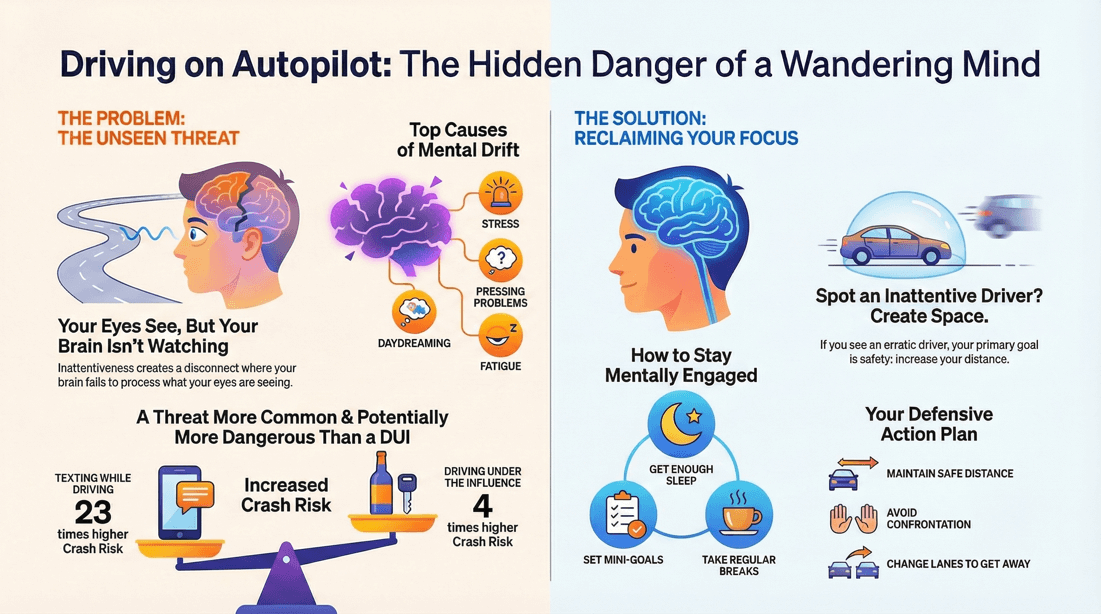
Inattentive
Pressing problems. Recipient of bad news. Prolonged stress. Daydreaming.
☠️ Alert:
🛈 Info:
🛈 Questions:


☠️ Dangers of inattentiveness while driving
Increased risk of accidents : When drivers are not paying attention to the road, they are more likely to miss important traffic signs, signals, and road conditions. This can lead to accidents, collisions, and even fatalities. Reduced reaction time : When drivers are distracted, their reaction time is slowed down, which can make it difficult for them to respond quickly to changing traffic conditions, such as sudden stops or swerves. I mpaired decision-making : When drivers are not focused on the road, they may make poor decisions that can put themselves and others at risk, such as driving too fast, following too closely, or failing to yield to other vehicles, running red lights, failing to yield, or making sudden and unsafe lane changes. Increased likelihood of speeding : Inattentive drivers may not realize they are driving over the speed limit, which can lead to dangerous situations on the road. Reduced awareness of surroundings : When drivers are daydreaming, they may not be fully aware of their surroundings, including other vehicles, pedestrians, and traffic signals. Increased risk of drifting out of lanes : Daydreaming can cause drivers to lose focus on their lane, leading to drifting and potentially causing a collision with another vehicle. Increased risk of falling asleep at the wheel : When drivers are not engaged and focused on the road, they may become drowsy and increase the risk of falling asleep at the wheel, a major cause of accidents on the road.
🛈 How to stop daydreaming when driving
Get enough sleep : Ensure you are well-rested before driving. Fatigue can contribute to daydreaming, so getting a good night's sleep can help you stay alert and attentive. Minimize distractions : Remove any potential distractions inside your vehicle, such as mobile phones, noisy passengers, or loud music. Keep your focus on the road. Set goals for the drive : Plan ahead and set specific goals for your journey. This could include focusing on your driving technique, paying attention to road signs, or maintaining a safe following distance from the vehicle ahead. Engage your senses : Activate your senses to stay present. Pay attention to the road, the sounds of the engine, the feel of the steering wheel, and the sights around you. Engaging your senses can help keep your mind focused on the task of driving. Take breaks if needed : If you find yourself daydreaming during a long drive, take regular breaks. Stop at a safe location, stretch your legs, get some fresh air, and give yourself a mental break before continuing your journey. Use driving aids : Some modern vehicles come equipped with driver-assistance features, such as lane departure warning systems or adaptive cruise control. These aids can help keep you focused and reduce the likelihood of daydreaming. Practice mindfulness : Mindfulness techniques can help you stay present and focused on the road. Take deep breaths, consciously observe your surroundings, and bring your attention back to the present moment whenever your mind starts to wander. Stay engaged with the road : Stay actively involved in the driving process. Use your mirrors frequently, anticipate potential hazards, and maintain a safe speed. By staying engaged, you reduce the chances of daydreaming. Share the driving responsibilities : If you have a travel companion who is also capable of driving, take turns driving. This can provide you with an opportunity to rest and prevent fatigue-induced daydreaming. Seek professional help if necessary : If daydreaming while driving is a persistent problem that affects your safety, consider consulting a healthcare professional or therapist. They can help you identify any underlying issues and provide appropriate guidance or treatment.
🛈 How stress can negatively affect driving
Reduced Concentration and Attention: Stress can lead to reduced concentration and attention, causing drivers to become easily distracted or lose focus on the road. Impaired Decision-Making: High-stress levels can impair decision-making abilities. Stressed drivers may struggle to make timely and rational decisions in traffic situations. Slower Reaction Times: Stress can lead to increased muscle tension and slower reaction times. This can be particularly dangerous in situations requiring quick responses, such as sudden stops or unexpected obstacles. Aggressive Driving Behavior: Stress can contribute to aggressive driving behaviors, such as tailgating, speeding, or engaging in confrontations with other drivers. Aggressive driving increases the risk of accidents. Decreased Situational Awareness : Stress may lead to tunnel vision, reducing a driver's overall awareness of the surrounding environment. This can result in overlooking important road signs, signals, or potential hazards. Physical Symptoms: Stress can cause physical symptoms, such as headaches, muscle tension, and fatigue. These symptoms can affect a driver's ability to maintain proper posture and control over the vehicle. Increased Risk of Road Rage : High stress levels can contribute to road rage, leading to aggressive and dangerous behavior on the road. This can escalate conflicts with other drivers. Difficulty with Multitasking: Stress may impair a driver's ability to multitask effectively. Tasks such as checking mirrors , signaling , and maintaining speed may become challenging under high-stress conditions. Fatigue and Exhaustion: Chronic stress can contribute to fatigue and mental exhaustion. Fatigued drivers are more prone to lapses in attention and may struggle to stay alert on the road. Compromised Emotional Well-Being: Stress can negatively impact emotional well-being, leading to mood swings, irritability, or anxiety . These emotional states can interfere with safe driving. Increased Vulnerability to Distractions : Stressed individuals may be more vulnerable to distractions, such as mobile phones, in-vehicle technologies, or external stimuli, further compromising attention on the road.
? How does inattentiveness affect driving performance?
Delayed Reaction Times
Impact : Inattentive drivers have slower reaction times, making it harder to respond quickly to sudden changes or hazards on the road, such as a vehicle stopping abruptly or a pedestrian crossing unexpectedly.
Impaired Judgment
Impact : Distracted drivers are more likely to make poor decisions, such as misjudging the speed and distance of other vehicles, which can lead to unsafe maneuvers like abrupt lane changes or failing to yield.
Reduced Situational Awareness
Impact : Inattentiveness leads to a lack of awareness of the surrounding environment, causing drivers to miss important cues like traffic signals, road signs, or the actions of other road users.
Inconsistent Speed and Lane Control
Impact : Distracted drivers often struggle to maintain a consistent speed and may drift between lanes. This erratic behavior can confuse other drivers and increase the likelihood of collisions.
Increased Likelihood of Missing Exits or Turns
Impact : Drivers who are not paying full attention are more prone to missing their intended exits or turns, which can lead to last-minute, unsafe maneuvers to correct their route.
Greater Risk of Rear-End Collisions
Impact : Inattentive drivers are more likely to be involved in rear-end collisions due to their delayed reactions and inability to maintain a safe following distance.
Higher Chances of Running Red Lights or Stop Signs
Impact : Drivers who are distracted may not notice traffic signals or stop signs in time, leading to violations and potential accidents at intersections.
Increased Risk of Single-Vehicle Accidents
Impact : Inattentiveness can cause drivers to lose control of their vehicle, resulting in accidents such as running off the road, hitting roadside objects, or rolling over.
Failure to Anticipate and Respond to Road Hazards
Impact : Distracted drivers are less likely to notice and react appropriately to hazards like debris on the road, animals, or unexpected actions by other drivers.
Poor Communication with Other Road Users
Impact : Inattentive drivers may fail to use signals properly, such as turn signals or hazard lights, leading to confusion and increased risk of collisions.
Conclusion
? What should I do if I notice another driver being inattentive?
Maintain a Safe Distance
Action : Increase the distance between your vehicle and the inattentive driver. This gives you more time to react if they make a sudden or erratic move. Rationale : Staying back reduces the risk of a collision if the inattentive driver swerves, brakes suddenly, or changes lanes without warning.
Avoid Confrontation
Action : Do not attempt to confront or signal the inattentive driver aggressively (e.g., honking excessively, flashing lights, or making gestures). Rationale : Confrontation can escalate the situation and potentially lead to road rage or further unsafe driving.
Be Extra Cautious
Action : Stay vigilant and be prepared for sudden actions by the inattentive driver. Avoid driving in their blind spots. Rationale : Anticipating unexpected moves allows you to react quickly and avoid accidents.
Use Your Horn Sparingly
Action : If the inattentive driver poses an immediate danger (e.g., drifting into your lane), use your horn briefly to alert them. Rationale : A short, gentle honk can serve as a warning without being aggressive.
Change Lanes or Adjust Your Route
Action : If it’s safe to do so, change lanes or take an alternative route to distance yourself from the inattentive driver. Rationale : Reducing your proximity to the inattentive driver lowers the risk of being involved in an accident.
Report the Behavior
Action : If the inattentive driving is severe (e.g., texting while driving, extreme swerving), and poses a significant risk, consider reporting it to local authorities. Pull over to a safe location to make the call. Rationale : Reporting dangerous behavior can help prevent potential accidents and increase road safety.
Stay Calm and Focused
Action : Keep your own stress and anxiety levels in check. Focus on driving safely and attentively. Rationale : Remaining calm ensures that you make rational and safe decisions while on the road.
Educate and Advocate
Action : Promote safe driving habits within your community and among your friends and family. Rationale : Increasing awareness about the dangers of inattentive driving can help reduce its occurrence and improve overall road safety.
Conclusion
? Can inattentiveness be more dangerous than driving under the influence?
Reaction Time
Inattentiveness : Distracted drivers may have slower reaction times because their attention is divided between driving and other tasks (e.g., texting, eating, adjusting the radio). DUI : Impaired drivers have slower reaction times due to the effects of alcohol or drugs, which hinder their ability to respond quickly to road conditions.
Situational Awareness
Inattentiveness : Distracted drivers often have reduced awareness of their surroundings, missing important cues such as traffic signals, stop signs, or the actions of other road users. DUI : Impaired drivers may also have reduced situational awareness, but their impairment is more consistent and affects all aspects of their driving.
Decision-Making
Inattentiveness : Distracted drivers are prone to making poor decisions because they are not fully focused on driving, leading to errors like unsafe lane changes or failing to yield. DUI : Impaired drivers have compromised judgment and may take unnecessary risks or make irrational decisions on the road.
Frequency and Commonality
Inattentiveness : Distracted driving is extremely common, especially with the widespread use of mobile devices. This high frequency increases the overall risk. DUI : While DUI is a major issue, it occurs less frequently than everyday distractions like texting or adjusting in-car systems.
Types of Distractions
Inattentiveness : Distractions can be visual (taking eyes off the road), manual (taking hands off the wheel), or cognitive (taking mind off driving). Multi-tasking with these distractions can compound the danger. DUI : The impairment is primarily cognitive and physical, affecting coordination, balance, and mental processing.
Studies and Statistics
Comparison : Research has shown that the impairment from texting while driving can be comparable to, or even worse than, driving under the influence of alcohol. For instance, texting while driving can increase the risk of a crash by 23 times, while DUI can increase the risk by up to 4 times.
Potential for Accidents
Inattentiveness : A momentary lapse in attention can result in severe accidents, such as rear-end collisions, side-swipes, or running off the road. DUI : The consistent impairment from alcohol or drugs leads to a higher likelihood of severe accidents, including head-on collisions, rollovers, and high-speed crashes.
Conclusion
? What are the causes of stress?
Personal Causes
Health Issues : Chronic illnesses, injuries, or other health problems can be significant sources of stress. Financial Problems : Debt, unemployment, or insufficient income to meet expenses. Major Life Changes : Events such as moving, divorce, marriage, or the death of a loved one. Personal Relationships : Conflicts or issues with family, friends, or partners. Daily Hassles : Ongoing minor irritations, such as traffic jams, deadlines, or minor disagreements.
Professional Causes
Job Pressure : High demands, tight deadlines, long hours, or heavy workload. Job Security : Fear of losing a job or instability in the workplace. Workplace Relationships : Conflicts with colleagues, managers, or subordinates. Lack of Control : Feeling powerless or unable to influence decisions affecting one's job. Career Development : Concerns about career progression, job changes, or lack of opportunities.
Social Causes
Social Isolation : Loneliness or a lack of social support. Relationship Conflicts : Issues with friends, family, or romantic partners. Peer Pressure : The influence of friends or peers, particularly in younger individuals. Social Obligations : The pressure to fulfill social roles or expectations.
Environmental Causes
Living Conditions : Poor housing, neighborhood safety, or high living costs. Noise and Pollution : Exposure to excessive noise, air pollution, or other environmental toxins. Natural Disasters : Experiencing or recovering from events like hurricanes, earthquakes, or floods. Climate : Extreme weather conditions or changes in weather patterns.
Biological Causes
Genetics : A family history of stress-related issues or mental health disorders. Hormonal Changes : Life stages like puberty, menopause, or pregnancy that affect hormone levels. Sleep Disorders : Insomnia or other sleep disturbances can lead to increased stress. Substance Use : Alcohol, drugs, or other substances can contribute to stress.
Psychological Causes
Personality Traits : Traits such as perfectionism, pessimism, or a tendency towards anxiety. Cognitive Patterns : Negative thinking, excessive worry, or unrealistic expectations. Past Trauma : Experiences of trauma or abuse can lead to ongoing stress.
Technological Causes
Digital Overload : Constant connectivity and information overload from devices and the internet. Cyberbullying : Online harassment or negative interactions on social media. Work-Life Balance : Difficulty separating work from personal life due to remote work or digital expectations.
Other Causes
Academic Pressure : Stress related to school, exams, or educational expectations. Legal Issues : Involvement in legal disputes or facing legal consequences. Caregiving Responsibilities : The demands of caring for children, elderly parents, or other dependents.